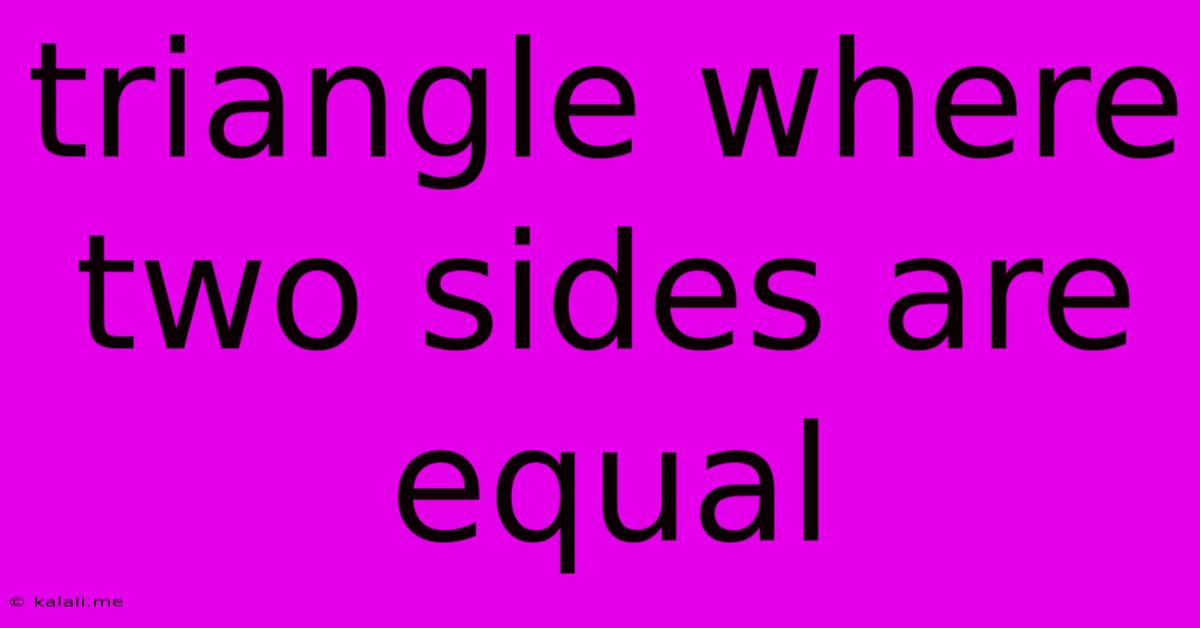Triangle Where Two Sides Are Equal
Kalali
May 31, 2025 · 3 min read

Table of Contents
Understanding Isosceles Triangles: Properties, Theorems, and Applications
Meta Description: Explore the fascinating world of isosceles triangles! This comprehensive guide delves into their unique properties, theorems like the Isosceles Triangle Theorem, and real-world applications. Learn how to identify and solve problems involving isosceles triangles.
Isosceles triangles, with their elegant symmetry, hold a special place in geometry. Defined by two sides of equal length, these triangles possess unique properties and theorems that make them fascinating to study. This article will explore the characteristics of isosceles triangles, delve into key theorems, and demonstrate their practical applications.
Defining an Isosceles Triangle
An isosceles triangle is a triangle with at least two sides of equal length. These equal sides are called the legs, and the angle between them is called the vertex angle. The side opposite the vertex angle is called the base. It's important to note that an equilateral triangle, with all three sides equal, is a special case of an isosceles triangle.
Key Properties of Isosceles Triangles
Several key properties distinguish isosceles triangles:
- Two Equal Sides (Legs): This is the defining characteristic.
- Two Equal Angles (Base Angles): The angles opposite the equal sides are also equal. This is a crucial property and forms the basis of several theorems.
- The Line Segment from the Vertex Angle to the Midpoint of the Base is Perpendicular to the Base: This line segment acts as both an altitude and a median. It bisects both the vertex angle and the base.
- The Altitude from the Vertex Angle Bisects the Vertex Angle: This is a direct consequence of the previous property.
The Isosceles Triangle Theorem
The Isosceles Triangle Theorem formally states that if two sides of a triangle are congruent, then the angles opposite those sides are congruent. Conversely, if two angles of a triangle are congruent, then the sides opposite those angles are congruent. This theorem is fundamental in solving problems involving isosceles triangles.
Solving Problems Involving Isosceles Triangles
Many geometry problems involve finding missing angles or side lengths in isosceles triangles. Utilizing the properties and theorems discussed above is key to successful problem-solving. For example, knowing that the base angles are equal allows you to find the measure of one base angle if the other is known, or to determine the vertex angle if the base angles are known. The relationship between the altitude, median, and angle bisector from the vertex angle provides additional tools for solving problems.
Real-World Applications of Isosceles Triangles
Isosceles triangles are not just theoretical constructs; they appear frequently in the real world. Their symmetrical nature makes them useful in various applications:
- Architecture: Many architectural designs incorporate isosceles triangles for aesthetic reasons and structural stability. Roof trusses often utilize isosceles triangles.
- Engineering: Isosceles triangles are used in various engineering structures, leveraging their strength and stability.
- Art and Design: The balanced symmetry of isosceles triangles is often used in artistic creations and design elements.
- Nature: Numerous natural formations, from certain types of crystals to leaf shapes, exhibit isosceles triangle patterns.
Beyond the Basics: Exploring Advanced Concepts
Further exploration into isosceles triangles could involve delving into more advanced geometric concepts such as:
- Circumcenter and Incenter: Investigating the location of these points in isosceles triangles.
- Area Calculation: Exploring different formulas for calculating the area of an isosceles triangle.
- Relationship to Other Triangles: Comparing and contrasting isosceles triangles with equilateral and scalene triangles.
By understanding the properties and theorems related to isosceles triangles, you gain a powerful toolset for solving geometric problems and appreciating the elegant symmetry found in this fundamental shape. Their presence in both theoretical mathematics and practical applications highlights their enduring importance in various fields.
Latest Posts
Latest Posts
-
Water Pressure Low After Turning Water Back On
Jun 01, 2025
-
That One Can Use As An Example
Jun 01, 2025
-
Render Animation Bledner How To Get Rid Of Lines
Jun 01, 2025
-
Generator To Dryer Plug Wiring Diagram
Jun 01, 2025
-
Does Changing The Frequency Of A Wave Change The Amplitude
Jun 01, 2025
Related Post
Thank you for visiting our website which covers about Triangle Where Two Sides Are Equal . We hope the information provided has been useful to you. Feel free to contact us if you have any questions or need further assistance. See you next time and don't miss to bookmark.